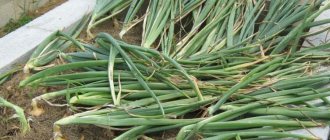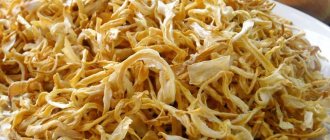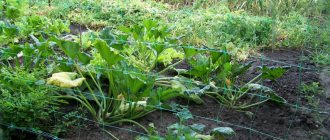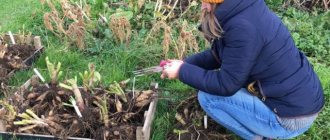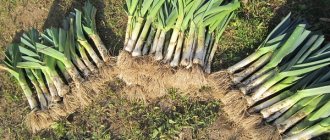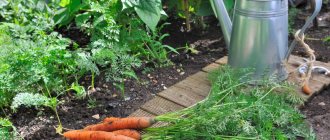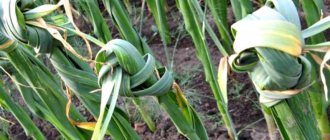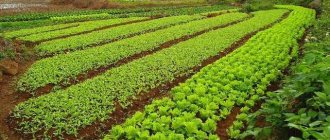Green feathers in the spring and young juicy turnips in early summer - harvest onions at any stage of maturity. In the second half of summer, the green feather becomes coarser and dries out - there is an outflow of nutritional juices from the above-ground part of the plant to the underground. Yellowing and lodging of the feather is the first sign of ripening of the vegetable. Summer residents are looking forward to this moment, because the main part of the beds is intended for harvesting turnips.
What happens if the onions are not dried?
If, after the onions are dug out of the ground, you do not dry them and immediately put them in boxes, you can lose the entire product. After harvesting from the garden, the onions are damp and contain particles of soil.
If they are put into boxes without drying, the putrefactive process will begin and they will rot. Also, pest larvae can accumulate in the upper layer of the husk. If the crop is not dried after harvesting, pests can destroy the bulbs.
IMPORTANT! If it rains during the harvesting period, you should choose a day with little precipitation and remove the vegetable and dry it under a canopy or indoors. Otherwise, it will quickly become saturated with moisture and will be unsuitable for winter storage. The collected vegetable is moved to a warm place where it is stored until completely dry.
When and how to remove onions from the beds
The onion, no matter what variety it is, ripens 3 or 4 months after planting. Indisputable signs that it is ready for harvesting are yellowing and lodging of the leaves, and the formation of dry, thin, shiny scales on the heads of a color characteristic of the variety. If it has darkened and become matte, this indicates that the plants have not been in the beds for a long time, and the harvest should have been harvested a long time ago.
Vegetables should be collected in sunny and dry weather. If it rains, you need to wait until warm and dry days set in. The soil may be a little damp, but it should not be soggy. Dig up the onions with a shovel or pitchfork, carefully lifting the heads along with the soil so as not to touch the bottom with the roots.
How to prepare the bulbs immediately after digging for further drying
In order for onions to be stored all winter after harvesting from the garden, they should be properly prepared and dried. The preparation and drying process is carried out according to the following algorithm:
- It is recommended to sort the collected onions from the garden into large and small specimens. Arrange according to varieties if necessary;
- separate damaged specimens;
- remove damaged husks that may contain larvae. Only the top husk needs to be removed. It is easy to identify; it is several tones darker than the main one and, as a rule, without shine;
- Using sharp scissors, trim the roots and tops. The tops are cut off in such a way that a stump of at least 5 cm remains;
- spread out in a thin layer and leave to dry for several days.
During the drying process, to ensure uniform drying, stir periodically. If you do not stir, only the top layers will dry. Also, during the drying process, the onions are laid in an even thin layer. Drying in large piles is not allowed.
In the oven
A good way to dry onions after harvesting is using the oven. Line a baking tray with baking paper and lay out the sliced rings in one layer. The oven is heated to 60 degrees and a baking sheet with slices is placed in it. There is no need to close the oven door. The drying procedure lasts approximately 6 hours. All this time, the onion rings are periodically turned over so that they do not darken or burn.
See also
When to harvest onions in the Black Earth Region, Voronezh and Belgorod regions, correct timingRead
As soon as the rings are completely dry, the cooled product is transferred to linen bags, cardboard boxes or a glass jar. The main thing is that air does not penetrate into the container. During the first few days, it is better not to close the container; the dry slices will completely dry out during this time. Only after this the containers are closed and stored in a dry, dark, cool place.
How to dry different types of onions after harvesting
In order for onions to be stored throughout the winter after harvesting from the garden, you need to know how to dry different types of onions.
How to dry onions after harvesting from the garden
High-quality and proper drying of onions allows not only to preserve them during the winter, but also to guarantee their taste. After the onions have dried and are placed in shallow boxes, it is important to dry them in a well-ventilated place for 10-14 days. This drying allows each bulb to be thoroughly dried and prevents the possibility of rot.
How to dry nigella onions after harvesting
After harvesting from the garden, nigella requires proper drying, otherwise the material will become moldy in a short time.
In order for nigella to retain its properties, you should carefully cut the seed pods from the garden bed. Scissors are used for this. The cut bulbs are placed in a fabric bag and hung in a well-ventilated place. Leave the material in this condition for 4-5 days.
After the bulbs are dried, it is recommended to gently knead them with your hands and remove the seeds. Place the nigella on the windowsill, having previously covered it with paper. Dry for 10 days, stirring regularly.
How to dry onion sets
Onion sets are small, so after harvesting from the garden they need to be dried for several days. However, before drying, it is recommended to carefully inspect the onions and select damaged ones.
IMPORTANT! Many summer residents do not recommend trimming the tops after drying onion sets. The tops allow it to survive throughout the winter. In the spring, a month before planting, the seedlings are cut off and placed in a warm place. This procedure not only preserves the seedlings, but also allows you to obtain high-quality planting material.
Benefits and harms
Both green and onions, as well as leeks, have beneficial properties for the human body.
Useful properties include:
- They have an antimicrobial effect;
- Prevention of colds (green onions);
- Stimulate etching processes;
- Normalize the functioning of the gastrointestinal tract;
- Affect sperm activity and testosterone production;
- Strengthens hair, nails and teeth;
- Improves memory;
- Strengthens the nervous system;
- Increase immunity;
- Prevents the formation of tumors;
- Promotes hematopoiesis;
- Activate growth processes (in children);
- Cleanses the skin.
Onions have practically no harmful properties.
Also, due to the sulfur content, onions cause bad breath.
How to dry onions for winter storage immediately after harvesting
After harvesting from the garden for the winter, onions can be stored using different methods. Each summer resident selects the most suitable one, depending on the quantity of products.
In braids
In order to dry the onions evenly after harvesting from the garden, it is recommended to tie the crop into braids. For this purpose, the tops are not trimmed. It is recommended to hang the tied onion in a well-ventilated place for several weeks.
Bunches
This method is used if, after collecting the bulbs from the garden, there is no time to weave braids. The bulbs are collected in bunches of 10 pieces and hung on the veranda or closed loggia.
Before hanging, the roots must be trimmed from the bulbs. Drying is necessary for several weeks, after which the bulbs are trimmed and stored for the winter.
IMPORTANT! Many summer residents try to dry onions collected from the garden in the oven. However, sudden exposure to heat can render the entire product unusable.
On the grid
If after harvesting there are a lot of onions from the garden, you can spread them out on stretched nets. It is necessary to stretch the net under a canopy so that in case of rain the product is not spoiled. Place in a thin layer on a mesh and stir every 3-4 days. Dry on this design for 2 weeks.
In the garden or indoors
If the weather is hot, you can dry the onions in the garden. To do this, after harvesting, it is folded along the bed and left for several days. After which the dried product is collected and placed in boxes.
If drying in the garden bed is not suitable, then it is necessary to spread it in a thin layer indoors, first laying paper or an old blanket on the floor. The room should be well ventilated.
IMPORTANT! It is not permissible to store several varieties of onions in one container. Since each variety may have certain requirements for conditions that are important to comply with.
Why is it necessary?
Drying dug up onions is an important preparatory stage in preparing them for winter storage. It is well known that only absolutely healthy bulbs, which are also in a phase of complete rest, can survive the winter normally.
Ideally, onions should be removed from the garden when they enter this phase. Yellowing and lodging of the feathers is a sign that metabolic processes are completing in the bulbs and preparations are underway for retirement. But it is not always possible during harvesting to determine whether the bulb is “sleeping” or is still awake.
Sometimes you have to consciously remove the onion that is still awake. This happens when heavy rains threaten to fall on an almost ripe onion bed. In such a situation, there is no point in leaving onions in the garden - already almost ripe, the onions will “pull” moisture and will rot badly in the future.
The drying that follows after digging the onions helps to finally put the bulbs into hibernation.
In addition, it makes it possible to identify and reject bulbs affected by rot, since in the vast majority of cases it is impossible to identify them when digging - the rot hides inside the bulb, without showing itself in any way on the outside. In a word, drying onions is a kind of soporific quarantine for them.
How long will onions last if dried properly?
If the product is thoroughly dried after harvesting from the garden, it can be stored throughout the winter. However, it is necessary to inspect the bulbs once a month and remove damaged ones.
In addition to the fact that the onions are not completely dried, the following factors can be the causes of rot in winter:
- has not fully completed the maturation process;
- leaves cut too short;
- the room is damp and not ventilated;
- The product is stored in paper boxes. Paper gets wet quickly and is a source of rotting.
Also, onions often begin to deteriorate in winter if the product was not sorted when harvesting from the garden. Within a few weeks, damaged specimens begin to rot and damage other vegetables.
Signs of a properly dried onion
The onion is completely dry and ready for trimming and further storage.
How can you tell if an onion is dry? The obvious signs are:
- The feathers are completely dry.
- The neck and roots also dried out.
- The bulb is even, hard and smooth.
- No mold observed.
Note: How else do you know that the onion is completely dry and ready for trimming? Stick your hand into the thicket of the bulbs. If the heads are still wet, then the hand will not pass, but if the heads are dry, it will enter easily.
How to store onions after drying?
After the vegetable has been thoroughly dried, it is placed in nets or wooden boxes for the winter.
To ensure that the product does not lose its taste, the storage location must be cool and regularly ventilated.
Dry basements, pantries, and attics are well suited. In apartment conditions, you can store it on a loggia or closed balcony. However, in winter it is recommended to insulate with an old blanket or jacket.
Once a month everything is reviewed and damaged copies are removed. It is also important in the spring to cull specimens that have sprouted young shoots. Such bulbs should be used for food or placed in water to grow greens on the windowsill.
Drying the onions
Having completed the preliminary drying, the bulbs are not immediately sent for storage, but continue to dry them using a variety of methods and means.
The most popular methods of drying are:
- in bulk;
- in grids;
- in braids.
At the end of drying, the bulbs are sorted for the last time, and excess husks, dried stems and root remains are removed from them. The bulbs are then placed in wicker baskets, cardboard or mesh boxes and sent for winter storage.
in bulk
The dried onions are brought into a dry room, placed on a flat surface and dried until tender. This method requires regular daily turning of the bulbs to ensure complete drying. Moreover, the thicker the mound, the more often the bulbs have to be turned over. Technically this is the simplest method, but it takes up a relatively large amount of time and useful space.
In grids
This drying method requires little preliminary preparation. The bulbs are sorted, the tops are shortened to 5-6 cm and the roots to 1-2 cm, and at the same time sorted by size: small, medium and large fractions. Sorting is needed to select the required grid size for each faction.
The onions are then placed in small nets and hung or stored. It is impossible to pack the nets tightly, since periodically the bulbs in them have to be stirred and sorted for better drying and to identify hidden areas of rot.
In braids
The oldest and most practical way of drying and storing onions. At the neck of the onion, a double folded strong twine is tied and the tops of the onion are woven into it. Then the second, third, etc. are woven in. At the end of the braiding, the loose ends of the twine are tied in a loop so that the braid can be hung.
Upon completion of the work, the finished braid can be hung on the wall or ceiling. What makes this method convenient is that all the bulbs in the spit are visible, can “breathe” freely, and are easy to sort through and discard if rot appears on any of them.
Onions in such braids can also be stored for winter without using any additional tricks. If necessary, taking an onion from such a braid is very simple - cut it off with scissors: quickly, conveniently and the braid does not unravel.
Gardening Tips and Tricks
To ensure that onions collected from the garden are stored all winter, it is recommended to follow the following proven tips from summer residents:
- The peel of a well-dried onion becomes shiny and golden. If a damaged husk is observed, it must be carefully removed. Since water and pest larvae often accumulate under the scales;
- Use wicker baskets for storage. The baskets allow air to pass through well. Therefore, the vegetable will be ventilated throughout the winter and will retain not only its appearance, but also its taste;
- To ensure that the harvest from the garden does not rot during the winter, the onions must be placed in shallow boxes and each layer must be sprinkled with wood ash;
- If damp specimens are observed in winter, the vegetables must be reconsidered and spread indoors to dry again. Often the cause of condensation is too high a level of humidity in the room;
- Do not dig up unripe vegetables. Summer residents who are in a hurry to harvest their crops before the rains often dig up green onions from the beds. Even if you trample on the feathers and cause them to turn yellow, this will not speed up the ripening of the bulb. It is necessary to ensure that the husk becomes strong and the onion is fully ripe. Otherwise, the duration of storage of such a crop in winter is no more than 1 month.
By following simple recommendations from experienced summer residents, you can extend the shelf life of onions. Even with long-term storage, the vegetable will not lose its appearance and taste.
Storage methods
In city apartments, it is convenient to keep a small supply right in the kitchen at normal room temperature.
In braids
Storing vegetables in braids is not only practical (the heads are well aerated and do not take up useful space), but also aesthetically pleasing: garlands of golden yellow, red, and white onions hung in the kitchen create a cozy, warm atmosphere, evoking memories of summer, the countryside, and the sun .
To ensure secure fastening, experienced housewives use rope or twine. We offer step-by-step instructions for weaving onion braids in the video:
Bunches
The dried stems of 10-15 bulbs are intertwined with rope or a strip of thick fabric. Then the “tails” of feathers that are too long are trimmed - the bunch is ready, you can hang it.
Storage in containers
Bulbs prepared for long-term storage are placed in wooden, plastic boxes, breathable fabric bags, nets, boxes, baskets. They are usually placed in secluded places (closets, insulated balconies, loggias). Several times during the winter, dried, rotting specimens are inspected, sorted, and thrown away.
For “cold” storage, the optimal temperature is considered to be 0… −3 ℃, for “warm” storage – not lower than +15 and not higher than 22 ℃ with a humidity of 60-70%
Method for drying green onions
Of course, everything is simpler with onions; they are easier to store in winter than green onions. But if you dry green onions, they will serve not only as a decoration for dishes, but also the vitamins in them will be preserved in full.
Some housewives freeze onions, but this method will not preserve all the piquancy and natural taste.
Therefore, it is advisable to dry the onions so that they fully retain their color and spice.
Green onions can be dried outdoors if the weather is nice and sunny.
Prepare it in advance: wash it, cut off the ends that have turned yellow, and select thick stems; they are not suitable for drying.
Next, you need to finely chop the onions and place them on a board or sieve in the shade. You should not place it in direct sunlight, they will have a negative effect on it. You need to stir the onions from time to time so that they dry evenly.
Many housewives, with the advent of the air fryer, prefer to dry onions in it. According to them, this is very convenient, since drying does not take much time.
For the process you need to chop the onion and place it on a wire rack for about half an hour. As for the heating temperature, it should be no higher than 70 degrees, then all the beneficial properties will be preserved.
You can find out all about the beneficial properties of dried dogwood on our website.
Read simple recipes for dogwood jam with stones here:
